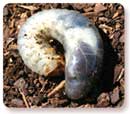Grubs

Grubs are the larvae of a variety of beetles. In the Southeast, the most common is the Japanese beetle. They are C-shaped worms, typically cream-colored, white or grayish-white with an orange-brown head, and they inhabit your turf in the root zone below the soil surface. Grubs feed on the root system of your turf and will cause the most problems in the months of August, September and October. There are several noticeable signs of a grub infestation in your turf:
1.) A drought-like wilting of your turf, even during periods of rain. Left unchecked, it will result in dead, brown patches of turf in rapidly increasing areas.
2.) Turf is easy to pull up with your hands. It will come up in sheets, as if you have just installed new sod.
3.) If you are digging in your garden and come across one or two grubs in one square foot of dirt, there’s probably no reason for concern. However, if you come across four or five in the same space, you have a population that needs controlling.
4.) A flock of birds (especially starlings) or small mammals tearing up your turf to feed on the grubs is a sure indication of infestation.
Because grubs attack the root system of your turf, they will ultimately destroy it if left unchecked.
Grubs can be controlled through applications of insecticides. However, for the insecticides to be effective, they must soak through the entire soil profile to work against the grubs at root level. Watering your turf thoroughly after insecticide application is essential to controlling grubs. The key to controlling any insect is understanding its life cycle.






